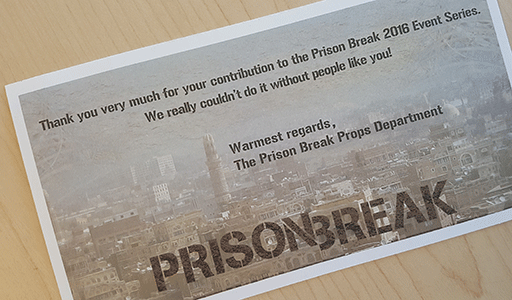 By Solmaz Sobhanifar, Postdoctoral Fellow at Strynadka’s Lab, CBR
By Solmaz Sobhanifar, Postdoctoral Fellow at Strynadka’s Lab, CBR
Consulting Prison Break
How many of us have watched a TV series or read an article where the scientific facts have been brazenly slaughtered in the name of entertainment? Although “suspension of disbelief” is a worthy effort (no one likes watching a sci-fi flick next to the guy constantly citing all the quantum physical laws that are being violated: you know who you are…), it need not be an exhausting one. To this end, many wise filmmakers and writers turn to the experts for insight and of course, our panel of scientists here at the CBR is eager to oblige!
Have you ever wondered what a container of blood found at a bottom of a deep lake would look like after 4 years? Of course not, why would you…? The producers of the TV show “Prison Break” however were very interested to know just this, and had their props crew consult CBRs own Associate Director, Prof. Ed Pryzdial, to find out. If any of you happen to watch the new season 5 of Prison Break, you would be happy to know that the blood found at the bottom of the lake was thoughtfully constructed based on the following interview:
Q. Prison Break crew: “We have a container of blood that has been stored at the bottom of a cold lake for 4 years. The question is what would the blood be like? Would it be congealed or separated? What colour would it be?”
A. Ed Pryzdial: “In the story, was the blood obtained via a hospital or other medical service? If not, there would have been no additives to prevent the blood from clotting/congealing. I would anticipate it would be a dark red (almost brown) oozy sludge. It would have clotted, but broken down over time. The red blood cells would possibly have settled initially as you suggested, but would have become leaky over time. The settling would not be so apparent since they would release their red colored contents. If there was the possibility of additives to prevent clotting (i.e. anticoagulants), then the blood would likely be even more liquid, but the red cells still leaky and not likely too much obvious settling. The color of the two situations would be similar regardless of additives…”
Q. Prison Break crew: “I believe if I made my blood a thick dark red solution, almost brown, should it be more like pea soup, being a thick liquid or more congealed like sour cream or yogurt? Would it be lumpy?
A. Ed Pryzdial: “I suggest the pea soup consistency, maybe a little lumpy like Grandma used to make it!”
Appetizing! And yes, Dr. Pryzdial’s grandma would have been proud to know the dark rusty-brown lumpy goo made out as the star of the show!
Upcoming Crime Novel
But our “bloody” tale doesn’t end there! In response to questions from author, Ken L Custance, regarding the forensic scene in 1969 for his upcoming book, our CBR Education Program Manager, Anna Sinova, did some forensic sleuthing of her own:
 Q. Ken Custance: “(I) have a couple of questions regarding blood typing way back in 1969. First of all – how long would it have taken to get back a blood sample analysis in BC in 1969 – where would the police send a sample at that time in BC? And would the technology in that day have been able to differentiate three different blood samples on one weapon?”
Q. Ken Custance: “(I) have a couple of questions regarding blood typing way back in 1969. First of all – how long would it have taken to get back a blood sample analysis in BC in 1969 – where would the police send a sample at that time in BC? And would the technology in that day have been able to differentiate three different blood samples on one weapon?”
A. Anna Sinova: “In 1969, it was possible to differentiate A, B, O, AB blood types on samples, as well as detect syphilis and/or rubella in the blood. However, DNA technologies, such as analysis of blood DNA, were not available until 1985. If the 3 different people had different blood types then it would be possible, but if they had the same blood type(s) then they would not be able to differentiate it. In terms of where the police sent their samples when lab work was required: in 1963, BC opened an RCMP crime detection laboratory; before that Regina had a primary RCMP crime lab. By 1969, Vancouver had a Serology section and a Chemistry section in the labs. The first time DNA evidence was admitted into court was 1987. The admissibility of DNA in court culminated in certification, accreditation, standardization and quality control guidelines for both DNA laboratories and the general forensic community.
Sounds like investigating crime in 1969 was no “bloody” picnic before modern forensic medicine. In that case, the butler must have done it!
A big thank you to Dr. Ed Pryzdial and Anna Sinova for introducing a touch of forensic pomp and intrigue to the CBR, and for helping bridge the gap between science and entertainment!



